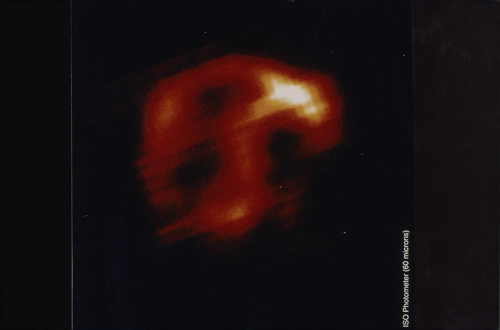From vestiges of earth formation to cosmic rays

A supernova explosion
A supernova explosion, one of the major cataclysm of the universe, is a rare event at the scale of a galaxy. It sows in the intergalactic space elements heavier than iron, that will contribute later in to the formation of stars and planets. Two of these heavy éléments, thorium and uranium, which are radioactive have survived due to their very long lifetimes. This photo of a very early event in universe was taken in 1996 on board of the ISO satellite.
CEA/ESA/ISO
Despite having evolved under constant exposure to radiations, humanity only realized the existence of this natural phenomenon in the 19th century. It was only from 1896, with Henri Becquerel’s discovery of uranic rays, that radioactivity was properly observed and efforts made to identify its origins.
Natural radioactivity originates mainly from radioelements present in stars billions of years ago. Traces of these radioisotopes, and of their descendants, can still be found in our environment.
Four elements released in the birth and death of stars have survived thanks to half-lives measured in billions of years: two isotopes of uranium (uranium 238 and uranium 235), thorium 232 and finally potassium 40 – which is ten million times less abundant than its nonradioactive isotope.
The nuclei of uranium and thorium disintegrate and give rise to their radioactive lineages of lighter elements. These descendants can be found in radioactive equilibrium (which is to say that for each descendant, as many decays at any given instant as fresh nuclei being formed) at the heart of uranium and thorium minerals. The most famous of these are radium and polonium, identified by Pierre and Marie Curie, and radon for its important contribution to natural radioactivity. Finally, after billions of years, the nuclei of uranium and thorium transform into stable nuclei of lead by way of numerous intervening generations.
Natural radioactivity can also arise from the bombarding of the Earth by energetic particles from outer space: cosmic rays. The Earth atmosphere and magnetic field combine to serve as an effective shield, capable of reducing the impact of these rays. The bombardment of atoms in the atmosphere can lead to the formation of radioactive elements, with the most well-known being carbon 14 and tritium.
All these sources of natural radioactivity are fairly small and remain constant on human time scale. The combined effect is either negligible or benign, as testified by the abundance of life-forms on the planet. When life first appeared on this planet, natural radioactivity levels were double what they are today.
Over the past few decades, new sources of radioactivity linked to human activities have been added to the list of natural sources. By far the most significant of these activities is the wide-ranging uses for radiations in healthcare and medicine.
NEXT : Radioactive Stardust : uranium and thorium families
NEXT : Cosmogenic Radioelements
Other articles on the subject « Natural Radioactivity »
Uranium and thorium origins
Radioactive substances older than the Earth The principal source of natural radiations on Earth i[...]
Cosmogenic Radioelements
Formation of radioactive atoms from cosmic rays The Earth is constantly being bombarded by &lsquo[...]
Natural Exposure
A chronic but benign exposure All exposure to radioactivity, whether natural or artificial, is me[...]
Ground Radioactivity
Telluric Exposure : Radiation which emanates from rocks The Earth crust contains a number of radi[...]
Human Internal Exposure
Our bodies are also… slightly radioactive All through our lives, we inhale and ingest radio[...]
Radioactivity in food
In our glasses and on our plates … The very acts of breathing and walking around make it im[...]